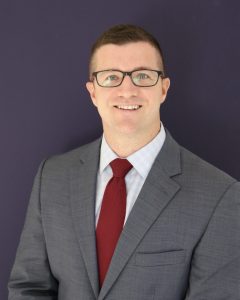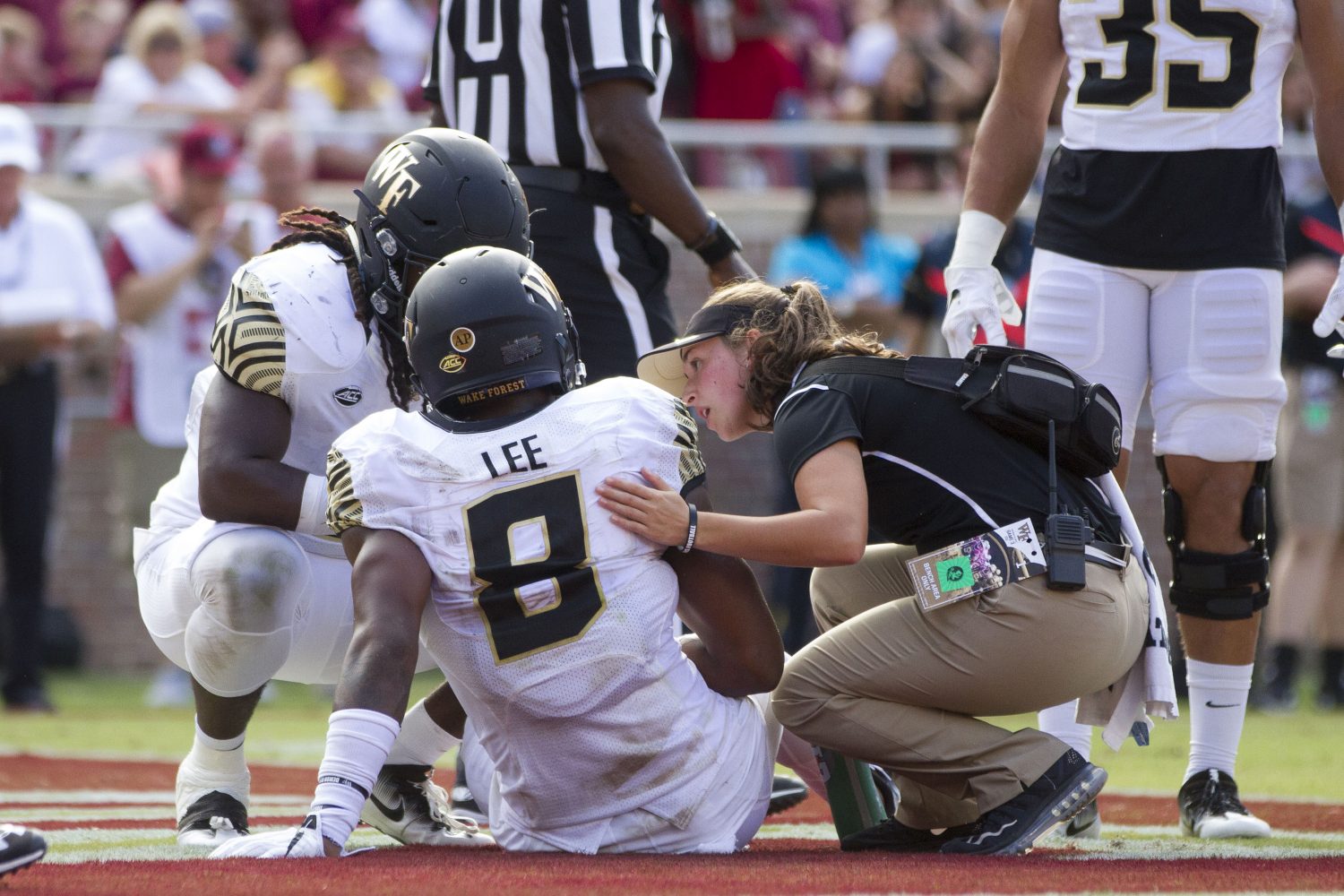Researchers in UConn’s College of Agriculture, Health and Natural Resources are working to highlight and support the important work athletic trainers do in secondary school settings.
Athletic trainers are healthcare professionals who work on and off the field with active individuals, and many provide medical care to athletes in professional leagues, colleges, and high schools as well. Athletic trainers are skilled in providing care for concussions or musculoskeletal injuries, and they are adept at quickly responding during medical emergencies such as sudden cardiac arrest or exertional heat stroke.
They also provide more routine care, like evaluation of injuries and illnesses, first aid, and taping and bracing to help prevent injuries. When injuries occur, they play an important role to help athletes safely return to sport.
Despite the proven benefits of having a qualified healthcare provider on staff, research from UConn’s Korey Stringer Institute (KSI) has determined that 34% of high schools with athletic programs in the U.S. do not have an athletic trainer, creating a clear need for research and advocacy in this area.
“InnovATive” Funding for Athletic Trainers
KSI provides research, education, advocacy and consultation to maximize performance, optimize safety and prevent sudden death for the athlete, warfighter and laborer. One way KSI is supporting the work of athletic trainers is through the innovATe program.

As a result of NFL concussion litigation in 2015, the Education Fund was established to promote safety and injury prevention in football players of all ages. KSI’s innovATe project, which provides funding to support athletic trainers in under resourced secondary school systems across the country, is one of the initiatives supported through the Education Fund. KSI had a preexisting relationship working with the NFL, making them a natural fit to lead the implementation of innovATe.
The program admitted its first round of participants in 2021: Boston Public Schools, Cincinnati Public Schools, Oakland Athletic League, and two rural school districts in Georgia. The 2022 cohort includes Cleveland Public Schools, Baltimore Public Schools, and schools in rural West Virginia and South Carolina. The third and final cohort will be selected in 2023.
Each cohort receives three years of funding which goes, primarily, toward an athletic trainer’s salary and necessary equipment and supplies.
Each recipient also works with a local healthcare partner to help establish their athletic training program. This is an important piece, as school administrators may not have the medical experience necessary to establish a sports medicine program. The partnership also helps create local support to help ensure the program’s success and longevity.
So far, these athletic trainers have helped diagnose and treat injuries like concussions as well as providing education about nutrition and helping athletes safely return to sport.
The program also connects these schools with NFL alumni.
Christianne Eason, director of innovATe and KSI president of sport safety, says in the existing cohorts, the Boston Public School system is a particularly interesting case.
“Boston is seen across the country and internationally as home to some of the best healthcare in the world and even in the city of Boston you have these health disparities for high school athletes,” Eason says.
Getting athletic trainers into these underserved school communities supports the overall health of the student athlete by providing them with access to a trained healthcare provider they may not otherwise have.
Eason says the goal of this program is to address health disparities in these areas around the country.
“These athletes need access to healthcare at the same level that college and professional athletes do because things that aren’t addressed in adolescence can become chronic problems later in life,” Eason says.
Addressing Burnout
Stephanie Singe, associate professor of kinesiology has been examining workplace issues facing athletic trainers, particularly burnout and work-life balance. Burnout is the result of prolonged, unaddressed stress that leads to physical and emotional exhaustion and fatigue. In Singe’s previous work, she has found work-life imbalance can facilitate burnout, and as athletic trainers continue to struggle with work-life balance, burnout must be addressed.

In her recent research study, she examines the factors that increase athletic trainer burnout in secondary school settings. She published her findings from this study in the Journal of Athletic Training earlier this year.
Singe said the impetus for this study arose from a combination of her own experience trying to balance work with caring for three children, including an infant, and a conversation with a PhD student about how athletic trainers in high school settings are understudied.
Singe notes a trend of young athletic trainers leaving the profession. Contrarily, the predominant logic is that younger professionals have fewer “life” responsibilities since they are less likely to have children or other family responsibilities than older athletic trainers. Yet, Singe found the opposite to be the case.
Athletic trainers under 30 and/or in the early career stage had both more work and personal burnout.
“It suggests that either they haven’t developed these coping strategies that might be effective at reducing their work stress or just the general transition into their jobs is stressful in itself,” Singe says.
Additionally, women reported experiencing greater burnout.
Singe used the Copenhagen Burnout Inventory which measures both work-related and personal burnout.
“We chose to use that because we’re recognizing that life does create stress and has the ability to create burnout,” Singe says.
Athletic trainers reported they did receive satisfaction from working with patients across all demographic groups, indicating the stress was coming from other aspects of the job, like its solitary nature and long hours.
“Athletic trainers are individuals who are highly rooted in their ability to provide for their patients,” Singe says. “They love caring for them and that’s a strong part of their identity.”
Singe says she would like to replicate this study in the college setting. She is also interested in looking at if burnout affects the quality of care athletic trainers provide.
Singe says, given these findings, it is important for high school athletic trainers, who usually work alone, to have a support network to facilitate their transition into practice.
Additionally, athletic training programs should teach students better coping mechanisms for burnout.
“In athletic training, time is the number one resource that leads to conflict, leads to burnout, leads to just feeling like you don’t have enough time for your personal life,” Singe says.
Singe says one of the most important ways to avoid burnout is to “feed your soul” and take time to do something purely for yourself every day and set boundaries to do those things.
“There needs to be this opportunity to engage in self-care practices and those self-care practices need to feed you as an individual,” Singe says.
Athletic Trainers in Emergencies
Robert Huggins’ research program helps provide the science behind advocating for the importance of athletic trainers, especially at the high school level. Huggins is an assistant research professor of kinesiology and president for research and athlete performance and safety at KSI.

In a recent study with Dr. Jonathan Drezner at the University of Washington School of Medicine, Huggins found that if an athletic trainer had access to an automated external defibrillator (AED), the survivability rate for sudden cardiac arrest was significantly higher. Without an AED, this rate is only 51% compared to 76% when the AED is used. If the AED is used within one to three minutes of collapse, the survival rate rises to nearly 90%.
“Having immediate access to an AED with someone trained to use it has been shown to improve survivability,” Huggins says.
The researchers published their findings in British Journal of Sports Medicine.
The rate of sudden cardiac arrest in school settings is approximately one in 24 to one in 294 primary and secondary schools per year.
Having access to an AED is the number one factor in student survivability in the event of cardiac arrest. Necessarily, a school needs to have an athletic trainer who knows how to use the AED on site and ready to jump into action during an emergency.
Having an emergency action plan in place is another critical element, says Huggins.
“The emergency preparedness piece should be required because we know when they are in place the survivability increases,” Huggins says. “Every student athlete deserves an emergency action plan so they can go home at the end of the day.”
Huggins is part of a grassroots effort to change policy state-by-state to require high schools with athletic programs to have athletic trainers on staff. Studies like this one help support this policy recommendation.
“Data such as these can help push and promote why we need these measures and resources in place,” Huggins says.
Licensure for All
Athletic trainers are medical professionals who play a critical role in keeping athletes safe before, during, and after play. Like all medical professions in the U.S., regulation of athletic trainers are determined at the state-level.
Forty-nine states and Washington D.C. have some form of regulation requirements for athletic trainers. California is the only state without any regulation.
According to the California Athletic Trainers Association, approximately one in six people working as athletic trainers in California do not have appropriate education or qualifications to be working as an athletic trainer.
KSI is working to support legislation to introduce requirements that would protect both the public and the profession, which is a priority for the National Athletic Trainer’s Association (NATA).
“Regulation is so important because it protects the public,” Eason says. “It helps ensure qualified people are practicing in this healthcare profession.”
California legislators have repeatedly introduced legislation to create requirements like those that exist in other states, which include ensuring a person has completed an accredited athletic training program and passed their board of certification exam. Yet, the bill has been vetoed three times; in 2010 by Gov. Schwarzenegger, and in 2014 and 2016 by Gov. Brown who claimed the bill created an “undue burden.”
Through the KSI-led Team Up for Sports Safety (TUFSS) initiative, KSI researchers travel to different states to help them adopt evidence-based best practice standards for sport safety. In their most recent visit to California, Eason and other researchers on the team met with key stakeholders to help support athletic trainers’ licensure legislation they plan to introduce in the next session.
This effort has also garnered support from the NFL, which has three teams in California.
Licensure requirements for athletic trainers help ensure that the people working in this field are qualified to provide safe and effective care as well as maintaining public trust in the profession, says Eason.
“The fact that California is the only state that doesn’t have athletic trainer regulations is bad for the public, bad for the patient, and bad for the practice,” Eason says.
Follow UConn CAHNR on social media



